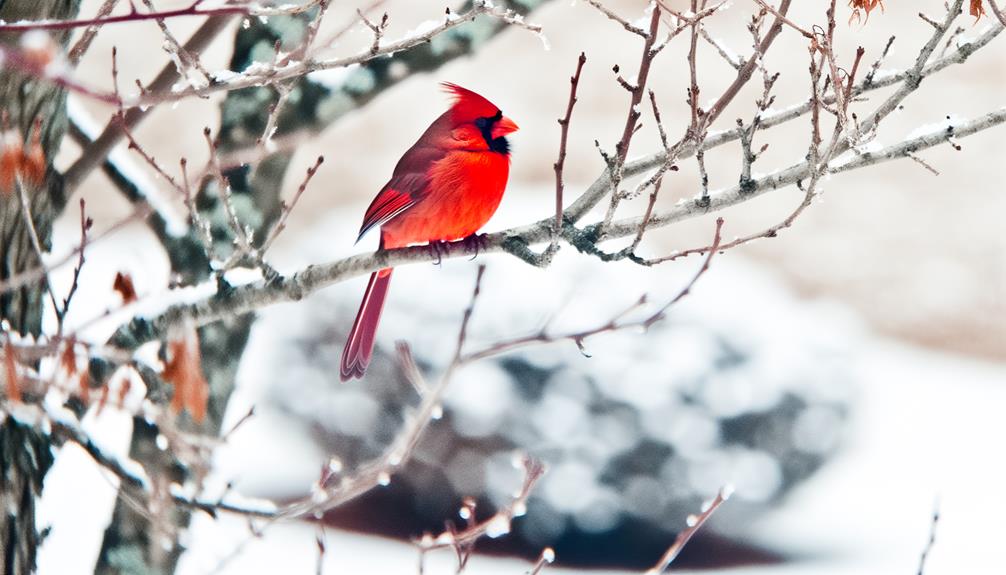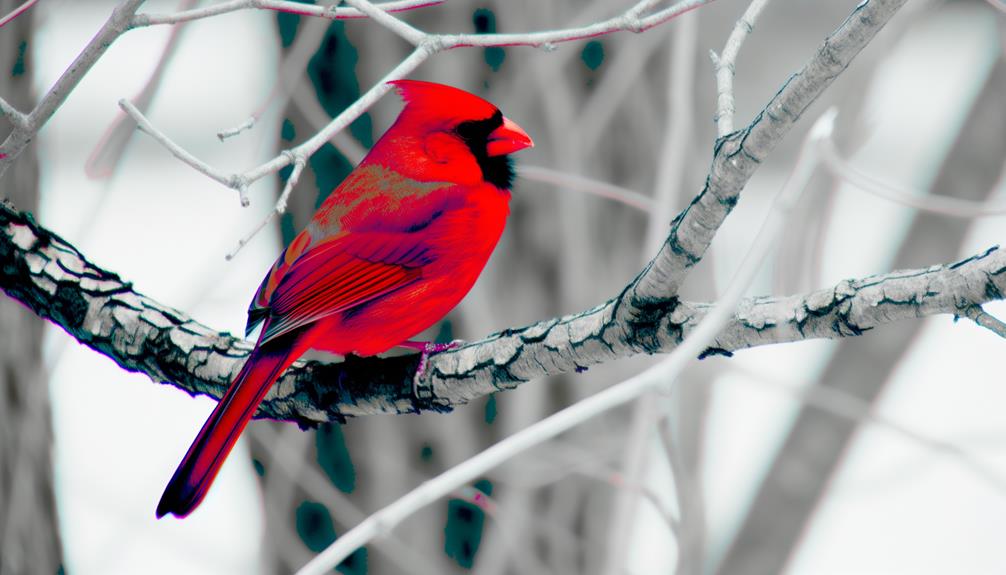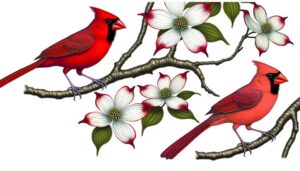Why Are Male Cardinals Red: A Coloration Example
Your male cardinal's brilliant red color is an example of how diet, genetics, and survival strategies intertwine in the wild. With a diet rich in carotenoids, these birds metabolize pigments, transforming them into lustrous red feathers.
This vibrant hue signals health, good genes, and dominance, attracting females while simultaneously acting as effective camouflage. Yet, it's more complex than it first appears.
Unraveling the full story reveals how red plumage also reflects cardinals' adept resourcefulness, their fitness for mating, and even the less obvious human impacts on their coloration. It's intriguing how so much is said through color, isn't it?

Key Takeaways
- A male cardinal's red color is an example of sexual selection, attracting females with its vibrant hue.
- This coloration serves as an indicator of health and good genes, signaling a desirable mate.
- The red plumage is also a demonstration of dominance and superiority in mating rituals.
- It exemplifies how diet, specifically carotenoids, can influence physical appearance in animals.
- The cardinal's color is an example of effective camouflage, blending with red berries and leaves.
Understanding Cardinal Colors

Have you ever wondered why male cardinals are so strikingly red? It's not by chance. Their vibrant hue is a product of diet and genetics combined.
You see, male cardinals consume a diet rich in carotenoids, pigments found in vegetation that convert into brilliant red coloring in the bird's feathers. Yet, it's not as simple as just munching on the right foods. Male cardinals possess a genetic advantage that allows them to metabolize and utilize these pigments more effectively than their female counterparts.
This results in the males' distinctive, radiant red plumage, a stark contrast to the more subdued hues displayed by the females. So, while you're admiring their bright red feathers, remember, it's nature's science at work, a demonstration of the power of genetics and diet.
The Significance of Red
You've likely noticed the striking red hue of the male cardinal, but have you considered its significance? From a symbolic perspective to its role in the animal kingdom, red carries a depth of meaning that's intriguing to unravel.
We'll also examine the cardinal's unique red shade, setting it apart from other species.
Symbolism Behind Red
Exploring the symbolism of red, it's notable that this vibrant hue, akin to the male cardinal's fiery plumage, often symbolizes power, passion, and energy in many cultures. It's a color that commands attention, stirring emotions and sparking action. It's no coincidence that stop signs and fire trucks are red!
Here's a quick glance at how red is perceived in various cultural contexts:
| Culture | Symbolism | Example |
|---|---|---|
| Western | Love, anger | Valentine's Day hearts, anger sign |
| Eastern | Good luck, celebration | Chinese New Year, Indian weddings |
| African | Death, mourning | Funeral rituals |
| Native American | Faith, beauty | Ceremonial dress, art |
| Middle Eastern | Sacrifice, courage | Flags, religious ceremonies |
From this, you can see that red's symbolism transcends boundaries, deeply embedded in our collective psyche.
Red in Animal Kingdom
Shifting our gaze from human cultures to the animal kingdom, it's striking to see how prominently red features in the natural world's color palette, often serving as a potent signal in matters of survival and reproduction.
Consider the red deer, where males with the reddest coats are more likely to win fights and mate. Even in the world of insects, the red ladybug's coloration acts as a warning to predators of its toxic nature.
In aquatic life, the red Siamese fighter fish uses its brilliant hue to stake territory and attract mates. Therefore, the color red in the animal kingdom isn't just about aesthetics. It's a beacon, a warning, a lure, and so much more.
It's the color of survival, of competition, of freedom.
Cardinal's Unique Red Hue
Diving into the avian world, it's impossible to overlook the male cardinal's radiant red plumage, a striking example of the evolutionary significance of color. The hue isn't merely ornamental; it plays crucial roles in survival and reproduction.
- Attraction: The cardinal's vibrant red color makes him more appealing to potential mates, increasing his chances of reproduction.
- Dominance: The deeper the red, the more dominant the cardinal. This color intensity signifies strength, discouraging potential rivals.
- Health Indicator: Diet and health have a direct correlation with the intensity of the red. A sickly bird can't produce the same vibrant hue, offering a visual health indicator.
The cardinal's color embodies freedom, strength, and vitality, making this bird a living proof of the power of evolution's paintbrush.
Cardinal Coloration and Evolution

Over time, the vibrant red coloration of male cardinals has evolved as a key factor in their survival and mating success. This evolutionary adaptation isn't arbitrary. It's the result of a complex dance between genetics, diet, and the environment.
The redder the male, the more likely he's healthy and well-fed, making him more attractive to females. This pigmentation is primarily derived from carotenoids, compounds they consume through their diet. However, the ability to convert these compounds into a stunning display of red feathers is encoded in their DNA.
Cardinals lacking this genetic trait mightn't be as successful. So, while you marvel at their brilliant hue, remember it's a reflection of a long evolutionary journey.
Survival Tactics: Cardinal Camouflage
Despite their striking red color, male cardinals use their plumage as a form of camouflage, blending seamlessly into their surroundings when necessary. Their deep red hue, while eye-catching, isn't always a disadvantage in the wild. In fact, it's a survival tactic, enabling them to hide effectively amongst the foliage.
Seasonal Camouflage: During fall and winter, the red cardinal's vibrant coloration blends perfectly with the red berries and leaves, providing excellent camouflage.
Shade and Light Play: Cardinals can manipulate their visibility, using shadows and light to obscure their bright plumage.
Movement Minimization: Cardinals often remain still in the face of danger, reducing motion to avoid attracting attention.
These survival tactics allow cardinals to maintain their freedom, undeterred by potential predators.
Red Cardinal Mating Rituals

You'll find the male cardinal's vibrant red hue isn't just for show; it plays an important role in their mating rituals.
The redness signifies dominance, enabling males to stand out and establish their territory.
From the female's perspective, a more vivid color often indicates a healthier, more desirable mate.
Significance of Cardinals Redness
In observing the mating rituals of red cardinals, it becomes evident that the intensity of a male's red coloration plays a pivotal role. This isn't just about aesthetics; it's an important part of the bird's reproductive strategy.
- Vibrancy of Color: The richer the red, the healthier the male. Females are attracted to intense hues as an indicator of good genes and fitness.
- Feather Quality: A well-maintained plumage suggests a male's ability to withstand environmental stresses, which is appealing to potential mates.
- Consistency of Color: Even distribution of red coloration across the body signals a robust immune system, further enticing the female.
Displaying Dominance Through Color
When observing red cardinals, you'll quickly notice that males employ their vibrant red coloration as a display of dominance during mating rituals. This isn't a mere aesthetic choice; it's a biological strategy deeply rooted in their DNA.
The more intense the red, the healthier and more dominant the male is perceived to be. This coloration is a direct result of carotenoids, pigments derived from their diet. They're not just showing off; they're demonstrating their ability to find abundant food resources, indicating their fitness as a potential mate.
The color display isn't static, either. It intensifies during mating season, underscoring the dynamic nature of this signaling mechanism. So, in the world of cardinals, red isn't just a color, it's a powerful statement of dominance.
Redness Attraction: Female Perspective
From a female cardinal's perspective, the gleaming red plumage of her male counterpart isn't just attractive—it's a display of his strength, health, and potential as a mate. She examines his fiery coat, the vibrancy of which is directly linked to his overall fitness. This is her freedom to choose, and she's discerning.
- Intensity of Color: The brighter the red, the healthier the male. She associates radiance with vitality, a promise of robust offspring.
- Consistency of Hue: A consistent color indicates high-quality foraging skills, implying resourcefulness, an appealing trait.
- Maintenance of Feathers: A well-kept, shiny plumage suggests the male is free from parasites, ensuring a safer environment for potential young.
Your understanding of her perspective enriches the appreciation of this natural spectacle, revealing the science beneath the beauty.
Effects on Cardinal Behavior
You'll notice that the vivid crimson color of male cardinals greatly influences their behavior, especially when it comes to territorial defense and mate attraction. This fiery hue isn't just a simple adornment; it's a powerful signal in the avian world. Observationally, the more intense the red, the more dominant the bird.
In terms of territorial defense, a cardinal's redness can intimidate rivals and deter intruders. They're fierce defenders, often engaging in aggressive displays to assert their dominance.
When it comes to mate attraction, females tend to prefer males with more vibrant plumage. It's believed that the redness signifies good health and superior genes. Essentially, the cardinal's red coloration is an embodiment of strength, fertility, and energy – all desirable traits in the wild.
Human Impact on Cardinal Colors

Particularly, human activities are greatly impacting the red coloration of male cardinals, altering not only their iconic appearance but also their behavior and survival strategies.
This change is primarily caused by:
- Habitat Destruction: As you expand your territories, you're reducing theirs. This leads to a scarcity of resources, including the specific fruits and insects that contribute to the red pigment.
- Pollution: Your industries expel pollutants, contaminating the cardinals' food and water sources, interfering with the absorption of the red pigment.
- Climate Change: Your carbon emissions are causing shifts in seasons, disrupting the breeding cycles and consequently, the color transformation of male cardinals.
The freedom you desire must take into account the freedom of other species to thrive in their natural environments.
Conclusion
So, how does a male cardinal's vivid red hue impact its life? It's not just about looking pretty.
This vibrant coloration plays pivotal roles in survival and mating, shaped by evolution and impacted by human activities.
It's an intriguing example of nature's intricate designs, showcasing the complex interplay between biology and behavior.
Next time you spot a red cardinal, remember, there's much more to its color than meets the eye.






